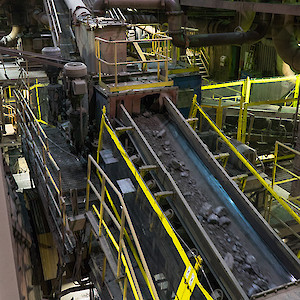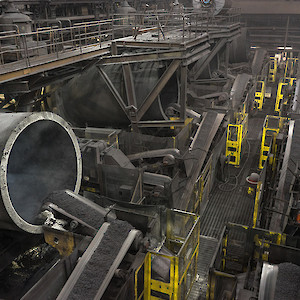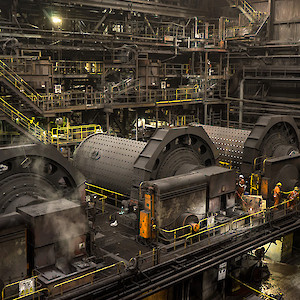Overview
Overview
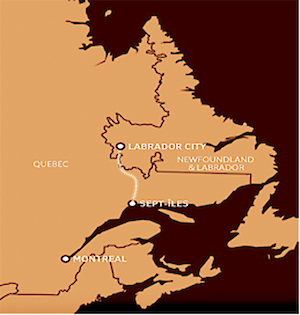
IOC is one of North America's leading producers and exporters of premium iron ore pellets and high-grade concentrate, and is among the top five producers of seaborne iron ore pellets in the world. It has been producing and processing iron ore from its current facilities in Labrador City, Newfoundland and Labrador since 1962. IOC is operated by Rio Tinto PLC, a world leader in iron ore mining and processing and IOC’s majority shareholder (58.7%). Mitsubishi Corporation (26.2%) and LIORC (15.1%) are IOC’s other shareholders.
IOC mines and produces iron ore pellets and concentrate at its facilities at Labrador City, Newfoundland and Labrador. Finished product is then transported by way of IOC’s 418 kilometer rail line to its port facilities at Sept-Îles, Quebec, where it is then shipped to various markets throughout the world.
Mine Operations
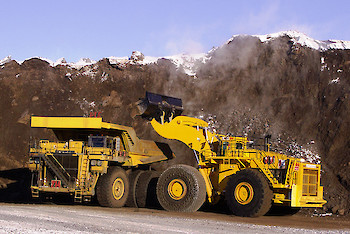 The iron ore deposits in the Labrador City area occur as specular hematite and magnetite, generally in the ratio of 65:35. IOC has mineral reserves and resources of 1.1 billion tonnes and 1.7 billion tonnes, respectively, with an average grade of approximately 38% iron.
The iron ore deposits in the Labrador City area occur as specular hematite and magnetite, generally in the ratio of 65:35. IOC has mineral reserves and resources of 1.1 billion tonnes and 1.7 billion tonnes, respectively, with an average grade of approximately 38% iron.
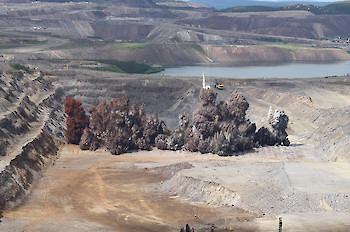 Mining is carried out using open pit techniques, which involve the drilling, blasting and hauling of waste rock and ore. Broken ore is loaded by electric shovels and transported by trucks to either automated trains or an overland conveyor which transport it to the concentrator. Currently the mining operations have a nominal capacity to deliver up to 55 million tonnes per annum of ore to the concentrator.
Mining is carried out using open pit techniques, which involve the drilling, blasting and hauling of waste rock and ore. Broken ore is loaded by electric shovels and transported by trucks to either automated trains or an overland conveyor which transport it to the concentrator. Currently the mining operations have a nominal capacity to deliver up to 55 million tonnes per annum of ore to the concentrator.
Concentrator
In order to extract the iron ore from the associated rock and silica gangue, the crushed ore is ground in four wet mills. Ground ore is then concentrated in the spiral plant using gravity spirals to increase the iron content from 38% to approximately 65 - 66%. A magnetic separation plant extracts magnetite from the spiral plant’s tailings, while a hematite recovery plant recovers fine particles of hematite from the tailings of the magnetic separation plant. IOC’s nominal concentrate production capacity is approximately 23.3 million tonnes per year, subject to ore quality. In addition to the high iron content, IOC’s iron ore concentrate for sale typically has very low phosphorus and low alumina. This chemistry helps steel producers lower the carbon footprint compared to lower quality grades and forms of iron ore.
Pellet Plant
The pellet plant converts concentrate to iron ore pellets that can be used directly in blast furnaces. Iron ore concentrate is received from the concentrating operations where it is ground in one of 11 ball mills. The ground concentrate is then mixed with certain additives and formed into balls 9.5 mm to 12.5 mm in diameter that are dried and then fired. The plant produces a variety of pellet products – standard acid pellets; low silica acid pellets; low silica fluxed pellets; direct reduction pellets, and has a nominal capacity to produce 12.5 million tonnes per year at the current product mix. Pellets typically have high iron content (65% to 67.5%), very low phosphorus and low sulphur, alumina and alkalis.
Québec North Shore and Labrador Railway (QNS&L)
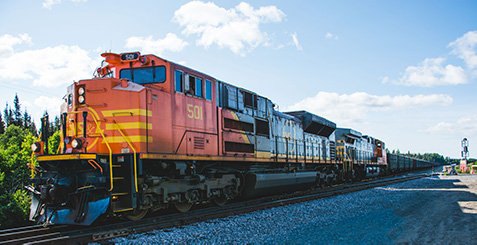 IOC’s wholly-owned subsidiary, QNS&L is used to transport iron ore pellets and concentrate 418 kilometres from IOC’s mining and production operations in Labrador City to its marine terminal and materials handling facility in Sept-Îles, Québec. QNS&L has capacity to haul 46 million tonnes per annum. It currently operates up to nine iron ore trains with each train generally 160 or 240 cars in length and each car is capable of carrying between 95 and 100 tonnes of iron ore. In addition to hauling IOC’s iron ore production, QNS&L also hauls third party iron ore from other producers in the Labrador Trough.
IOC’s wholly-owned subsidiary, QNS&L is used to transport iron ore pellets and concentrate 418 kilometres from IOC’s mining and production operations in Labrador City to its marine terminal and materials handling facility in Sept-Îles, Québec. QNS&L has capacity to haul 46 million tonnes per annum. It currently operates up to nine iron ore trains with each train generally 160 or 240 cars in length and each car is capable of carrying between 95 and 100 tonnes of iron ore. In addition to hauling IOC’s iron ore production, QNS&L also hauls third party iron ore from other producers in the Labrador Trough.
Sept-Îles Terminal
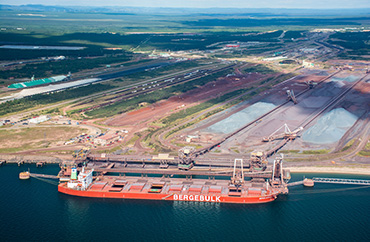 IOC’s wholly owned and operated marine terminal and materials handling facility in Sept-Îles, Québec receives and stockpiles iron ore pellets and concentrate for sale from Labrador City for eventual loading into ships. Received iron ore pellets and concentrate for sale are automatically dumped, weighed and transported to stockpiles. The dumper capacity is 20.6 million tonnes per annum. The stockpile yard has the capacity to store 4.5 million tonnes of iron ore products. During shiploading, product is reclaimed from the stockpiles and transported by conveyor to the docks where two travelling shiploaders transfer the iron ore product onto the docked freighters. The shiploading capacity is 20.9 million tonnes per annum. The Sept-Îles terminal operates year-round and can handle both lake and ocean-going vessels with a capacity of between 25,000 and 255,000 tonnes.
IOC’s wholly owned and operated marine terminal and materials handling facility in Sept-Îles, Québec receives and stockpiles iron ore pellets and concentrate for sale from Labrador City for eventual loading into ships. Received iron ore pellets and concentrate for sale are automatically dumped, weighed and transported to stockpiles. The dumper capacity is 20.6 million tonnes per annum. The stockpile yard has the capacity to store 4.5 million tonnes of iron ore products. During shiploading, product is reclaimed from the stockpiles and transported by conveyor to the docks where two travelling shiploaders transfer the iron ore product onto the docked freighters. The shiploading capacity is 20.9 million tonnes per annum. The Sept-Îles terminal operates year-round and can handle both lake and ocean-going vessels with a capacity of between 25,000 and 255,000 tonnes.


